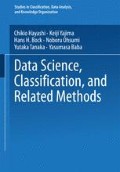Summary
Well-known cluster analysis techniques like for instance the K-means method can be improved in almost every case by using adaptive distances. For this one has to estimate at least “appropriate” weights of variables, i.e. appropriate contributions to cluster analysis. Recently, adaptive classification techniques for two class models are under development. Here usually both the weights of variables and the weights (masses) of observations play an important role. For instance, observations that are harder to classify get increasingly larger weights. Quite successful applications of these techniques can be reported from the area of credit scoring systems for consumer loans or credit cards. The software ClusCorr (running under Microsoft EXCEL) perform classification, cluster analysis and multivariate graphics of (huge) high-dimensional data sets containing numerical values (quantitative or categorical) as well as non-numerical information.
Access this chapter
Tax calculation will be finalised at checkout
Purchases are for personal use only
Preview
Unable to display preview. Download preview PDF.
References
Bock, H. H. (1987): On the interface between cluster analysis, principal component analysis, and multidimensional scaling, In: Multivariate statistical modeling and data analysis, Bozdogan, H. and Gupta A. K. (eds.), 17–34, D. Reidel, Dordrecht.
Bock, H. H. (1996): Simultaneous visualization and classification methods as an alternative to Kohonen’s neural networks, In: Classification and Multivariate Graphics: Models, Software and Applications, Mucha, H.-J. and Bock, H. H. (eds.), Report No. 10 (ISSN 0956–8838), 15–24, Weierstrass Institute for Applied Analysis and Stochastics, Berlin.
Fahrmeir, L. and Hamerle, A. (1984): Multivariate statistische Verfahren, De Gruyter, Berlin.
Hubert, L. J. and Arabie, P. (1985): Comparing partitions, Journal of Classification, 2, 193–218.
MacQueen, J. (1967): Some methods for classification and analysis of multivariate observations, In: Proc. 5th Berkeley Symp. Math, Statist. Prob. 1965/66, LeCam, L. and Neyman, J. (eds.), Vol. 1, 281–297, Univ. California Press, Berkeley.
Michie, D. M., Spiegelhalter, D. J. and Taylor, C. C. (eds.)(1994): Machine Learning, Neural and Statistical Classification,Ellis Horwood, Chichester.
Mucha, H.-J. (1992): Clusteranalyse mit Mikrocomputern, Akademie Verlag, Berlin.
Mucha, H.-J. (1995): XClust: clustering in an interactive way, In: XploRe: an Interactive Statistical Computing Environment, Hardie, W., Klinke, S., and Turlach, B. A. (eds.), 141–168, Series Statistics and Computing, Springer-Verlag, New York.
Mucha, H.-J. (1996a): Distance based credit scoring, In: Classification and Multivariate Graphics: Models, Software and Applications, Mucha, H.-J. and Bock, H. H. (eds.), Report No. 10 (ISSN 0956–8838), 69–76, Weierstrass Institute for Applied Analysis and Stochastics, Berlin.
Mucha, H.-J. (1996b): ClusCorr: cluster analysis and multivariate graphics under MS EXCEL, In: Classification and Multivariate Graphics: Models, Software and Applications, Mucha, H.-J. and Bock, H. H. (Eds.), Report No. 10 (ISSN 0956–8838), 97–105, Weierstrass Institute for Applied Analysis and Stochastics, Berlin.
Mucha, H.-J. and Klinke, S. (1993): Clustering techniques in the interactive statistical computing environment XploRe, Discussion Paper 9318. Institute de Statistique, Universite Catholique de Louvain, Louvain-la-Neuve.
Nishisato, S. (1980): Analysis of Categorical Data: Dual Scaling and its Applications, University of Toronto Press, Toronto.
Nishisato, S. (1994): Elements of Dual Scaling: An Introduction to Practical Data Analysis, Lawrence Erlbaum Associates, Publishers, Hillsdale.
Quinlan, J. R. (1993): C4.5: Programs for Machine Learning, CA: Morgan Kaufmann, San Mateo.
Author information
Authors and Affiliations
Editor information
Editors and Affiliations
Rights and permissions
Copyright information
© 1998 Springer Japan
About this paper
Cite this paper
Mucha, HJ., Siegmund-Schultze, R., Dübon, K. (1998). Adaptive Cluster Analysis Techniques — Software and Applications. In: Hayashi, C., Yajima, K., Bock, HH., Ohsumi, N., Tanaka, Y., Baba, Y. (eds) Data Science, Classification, and Related Methods. Studies in Classification, Data Analysis, and Knowledge Organization. Springer, Tokyo. https://doi.org/10.1007/978-4-431-65950-1_24
Download citation
DOI: https://doi.org/10.1007/978-4-431-65950-1_24
Publisher Name: Springer, Tokyo
Print ISBN: 978-4-431-70208-5
Online ISBN: 978-4-431-65950-1
eBook Packages: Springer Book Archive

